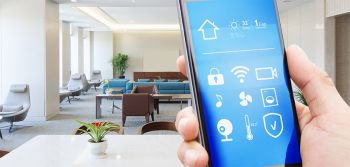Lighting and the Internet of Things
- August 10, 2021
- Best Practices
- Lighting

Most people of a certain age can remember what it was like waiting for the screech of a dial-up internet connection or talking on a “car phone” the size of a brick. Oh, how times have changed, in not so many years. Technology is evolving so fast there’s even a term for it: technological Darwinism. It’s the idea that by the time you get the latest-and-greatest tech gadget home and learn how to use it, it’s obsolete.
With the evolution of all things smart — smart washers, smart refrigerators, smart stoves, smart houses — comes a new term that seems to describe the way life as we know it is moving: The Internet of Things. It’s neither catchy nor informative, so there’s been a lot of confusion about what, exactly, the Internet of Things is.
What is the IoT?
Quite simply, it’s everything “smart,” except your computer, tablet and smartphone. It’s the ability to connect things — stoves, fridges, home cameras, anything — to the Internet. It’s about things that aren’t computers themselves, but embedded with computer technology and WiFi capabilities. It’s the refrigerator that can scan itself and alert you when you’re out of milk, or the stove that you can turn on from an app on your phone.
The explosion of all things smart happened because of several factors, namely broadband Internet being everywhere, WiFi connections being everywhere, and smartphones being everywhere. There’s an app for everything. Why shouldn’t there be one for turning on your stove or doing your laundry? It’s about connecting your things to each other and to you and to other devices.
Gartner research predicts that by 2020, we’ll have 26 billion things on the IoT. Others estimate that number to reach to 100 billion and more.
And it’s not just about the things in your personal life. The IoT is migrating to the workplace as well. Components of machines. Jet engines. And yes, even lighting.
THE IoT AND LIGHTING
The applications and uses of the IoT in lighting have vast, dare we say endless, possibilities. Networked lighting control systems are nothing new, but imagine taking that to the next level.
A lighting system can include intelligence, sensors, connectivity and communication. While it’s great to have centralized, easy, one-touch control of lighting, the real pot of gold here is in data collection, monitoring, customer convenience and worker safety.
Here’s how it might look:
RETAIL
- Tracking. The lighting fixtures can be equipped with sensors to track shoppers through the store. This gives owners and managers data on where people go, where the “hot spots” are, which aisles or areas get the most traffic. That’s powerful data about ideal product placement locations and a concrete view of how shoppers shop.
- A personalized GPS. Imagine a customer walking into a store larger than a couple of football fields needing one item, and not knowing where to find it. No problem. Fire up the big-box store’s app, plug in the name of the item and be directed to its location via IoT lighting. The lights know where it is. They can also plan a customer’s route through the store.
- Promotions. In so many industries today, it’s all about the customer experience. Lighting can track where customers are in the store and deliver personalized promotions — something’s on sale one aisle over — to their app.
HEALTHCARE
- Tracking equipment. Imagine a busy, hectic ER, and a doctor needs an ultrasound machine, stat. Lighting can find that machine in an instant, saving precious minutes that might mean the difference between life and death.
- Monitoring care. We’ve all heard about the abuses in eldercare facilities. IoT lighting can give families peace of mind that their loved ones are being treated with love and care, or if he or she has fallen or is in some other kind of distress, because the lights are monitoring what goes on in the rooms.
MANUFACTURING
- Tracking equipment and other assets. You’ll know where every piece of equipment, and every other asset is, every time.
- Monitoring workers. We don’t want to sound like Big Brother, but IoT lighting can not only monitor workers in the factory or plant, but it can be the arbiter when workers’ comp claims are made because of on-the-job injuries.
SECURITY
In all industries and sectors, from the manufacturing floor to the catwalk, even including parking ramps, parking lots and city streets, if it’s lit with an IoT light, it can have a sensor.
IMPLICATIONS AND HOW TO PREPARE FOR IoT
We used the term Big Brother, and for some people, that’s exactly what this feels like. The lights are the all-seeing eye? Well, yes. That’s exactly what they can be, and the implications can be vastly beneficial for businesses in all industries.
But, we’re not there yet. Issues include:
- Data analytics. The lighting can give you all the data in the world, but you’ll need someone to analyze it. The bad news about this is, data analytic specialists are the most sought-after profession out there right now.
- Data storage. All of this data needs to be stored someplace. Do you have enough data storage capabilities? If not, it needs to be a part of your budget.
- Budget. New construction is a perfect time to install IoT lighting, but if you’re replacing, not rebuilding, it has to be factored into your bottom-line budget.
- Data breach concerns. If this lighting is collecting all of this data, what if the system is hacked? Security needs to be a top concern of any business that installs IoT.
In summary, the Internet of Things is here, and lighting can and will be a huge part of it. To learn more about how IoT lighting can benefit your business, contact the experts at Van Meter.

ARTICLE BY:
NICK BENNETT
EMPLOYEE-OWNER, LIGHTING SPECIALIST
For more information, please reach out to your sales representative or call 1-800-247-1410.